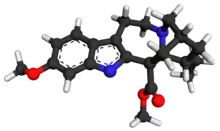Isovoacangine
Isovoacangine is a naturally occurring substance related to voacangine. It showed negative chronotropic and negative inotropic activity.[1]
 | |
 | |
| Identifiers | |
|---|---|
| |
| PubChem CID | |
| ChemSpider | |
| ChEMBL | |
| Chemical and physical data | |
| Formula | C22H28N2O3 |
| Molar mass | 368.477 g·mol−1 |
| 3D model (JSmol) | |
| |
| |
Chemistry
Derivatives
3-Hydroxyisovoacangine and 3-(2'-oxopropyl)isovoacangine are derivates of isovoacangine.[2]
Natural occurrence
It occurs naturally in many Tabernaemontana (milkwood) species such as Tabernaemontana pachysiphon and Tabernaemontana_divaricata.[3][4]
See also
References
- Pratchayasakul W, Pongchaidecha A, Chattipakorn N, Chattipakorn S (April 2008). "Ethnobotany & ethnopharmacology of Tabernaemontana divaricata" (PDF). The Indian Journal of Medical Research. 127 (4): 317–35. PMID 18577786. S2CID 1119874.
- Danieli B, Palmisano G (January 1987). "Alkaloids from Tabernaemontana.". In Brossi A (ed.). The alkaloids: Chemistry and Pharmacology. 27. Academic Press. pp. 1–130 (82). ISBN 978-0-08-086551-5.
- "Tabernaemontana undulata - Useful Tropical Plants". tropical.theferns.info.
- Kam TS, Loh KY, Wei C (November 1993). "Conophylline and conophyllidine: new dimeric alkaloids from Tabernaemontana divaricata". Journal of Natural Products. 56 (11): 1865–71. doi:10.1021/np50101a001.
This article is issued from Wikipedia. The text is licensed under Creative Commons - Attribution - Sharealike. Additional terms may apply for the media files.